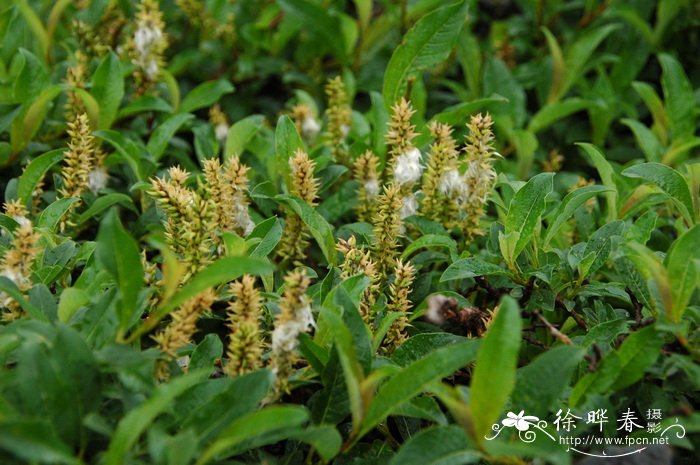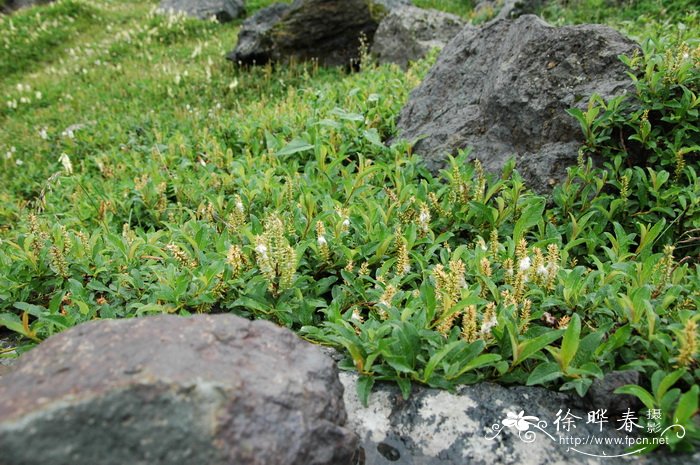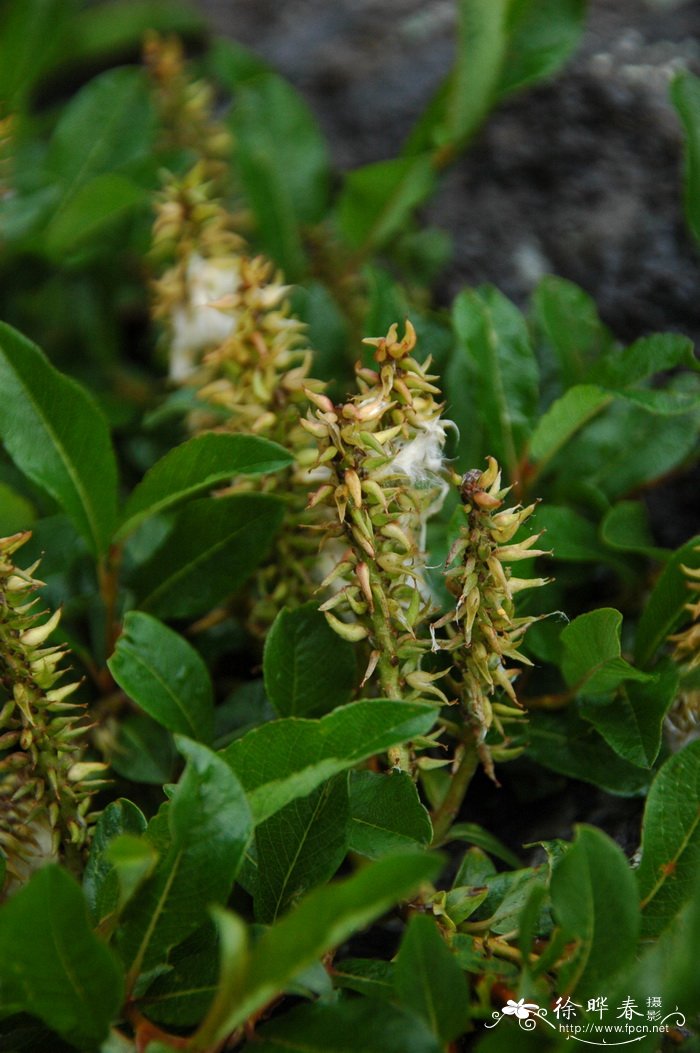长白柳Salix nummularia
中文名(Chinese Name):长白柳
学名(Scientific Name):Salix nummularia Andersson
英文名(English Common Name):barren ground willow
别名(Chinese Common Name):
异名(Synonym):Salix polyadenia Hand.-Mazz. Salix polyadenia var. tschanbaischanica (Y. L. Chou et Y. L. Chang) Y. L. Chou Salix tschanbaischanica Y. L. Chou et Y. L. Chang Salix tundricola Schljak. Salix nummularia subsp. tundricola (Schljak.) A.& D. Löve
科属(Family & Genus):杨柳科(Salicaceae)柳属
形态特征(Description):草本状匍匐小灌木。枝长达40厘米,最粗达1厘米,树皮红褐色;枝不生不定根,黄褐色,无毛。芽长椭圆状卵形,长2-3毫米,无毛。叶倒卵状椭圆形,或近圆形,或椭圆形,长0.5-1.7厘米,宽0.5-1.5厘米,先端圆或钝头,或微凹,基部圆形或圆楔形,革质,上面暗绿色,下面绿色,幼时有白色毛,后无毛;叶柄长达3毫米,幼时有毛,后无毛;托叶小,披针形,无毛。花与叶同时开放;雄花序生于短枝顶端,无梗,卵形,长8毫米,有10-20花;雄蕊2,离生,花丝无毛,花药红色;苞片圆形,长1毫米,黄褐色,有长白毛;腺体2,长约0.3-0.4毫米,腹腺卵圆形或圆形,有时2裂,背腺2-3深裂;雌花序生于具短柔毛的小枝顶端,长5-8毫米,有10-20花;子房似披针形,先端长渐尖,长3-4毫米,粗1毫米,绿色或带黄色,无毛,有子房柄,长约1毫米(果柄伸长),花柱长0.5毫米,柱头4裂;苞片圆形,直径约1毫米,黄褐色,有白色长毛;腺体2,腹腺常2-3(4)裂,比子房柄长约2倍。背腺较短。花期7月上旬,果期7月中、下旬。
分布(Distribution):产吉林,生于长白山高山苔原。
用途(Use):用种子繁殖。可为野生动物食料。在高山有保持水土的好作用。
引自中国植物志英文版:FOC Vol. 4 Page 240
Salix nummularia Andersson in A. de Candolle, Prodr. 16(2): 298. 1868.
多腺柳 duo xian liu| Salicaceae | Salix
Salix polyadenia Handel-Mazzetti; S. polyadenia var. tschanbaischanica (Y. L. Chou & Y. L. Chang) Y. L. Chou; S. tschanbaischanica Y. L. Chou & Y. L. Chang.
Shrubs procumbent, dwarf; bark russet. Branches to 80 cm, (2-)10 mm thick; branchlets yellowish brown, pilose when young, glabrescent. Buds oblong-ovoid, 2-3 mm, glabrous. Stipules present; petiole ca. 3 mm, pilose when young, glabrescent; leaf blade obovate-elliptic, suborbicular, or elliptic, 0.5-1.7 × 0.5-1.5 cm, leathery, abaxially green, villous when young, glabrescent, adaxially dull green, base rounded or rounded-cuneate, margin entire, apex rounded, obtuse, or retuse. Flowering coetaneous. Catkins terminal. Male catkin ovoid, ca. 8 mm, 10-20-flowered; bracts yellowish brown, orbicular, ca. 1 mm, long pubescent. Male flower: glands 2, 0.3-0.4 mm, adaxial gland ovate or orbicular, sometimes 2-cleft, abaxial gland 2- or 3-parted or entire; stamens 2, distinct, glabrous. Female catkin 5-8 mm, 10-20-flowered; bracts as in male catkin. Female flower: adaxial gland usually 2- or 3(or 4)-lobed, ca. 2 × as long as stipe, abaxial gland shorter than adaxial gland; ovary sublanceolate, apex acuminate, 3-4 mm, glabrous; stipe ca. 1 mm,
elongated in fruit; style ca. 0.5 mm; stigma 4-lobed. Fl. Jul, fr. Jul.
Alpine tundra; 2200-2600 m. Jilin (Changbai Shan) [Russia].
The Chinese record in FRPS of the the NW North American species Salix rotundifolia Trautvetter is referable to S. nummularia.
The Chinese record in FRPS of the the NW North American species Salix rotundifolia Trautvetter is referable to S. nummularia.



(责任编辑:徐晔春)
学名(Scientific Name):Salix nummularia Andersson
英文名(English Common Name):barren ground willow
别名(Chinese Common Name):
异名(Synonym):Salix polyadenia Hand.-Mazz. Salix polyadenia var. tschanbaischanica (Y. L. Chou et Y. L. Chang) Y. L. Chou Salix tschanbaischanica Y. L. Chou et Y. L. Chang Salix tundricola Schljak. Salix nummularia subsp. tundricola (Schljak.) A.& D. Löve
科属(Family & Genus):杨柳科(Salicaceae)柳属
形态特征(Description):草本状匍匐小灌木。枝长达40厘米,最粗达1厘米,树皮红褐色;枝不生不定根,黄褐色,无毛。芽长椭圆状卵形,长2-3毫米,无毛。叶倒卵状椭圆形,或近圆形,或椭圆形,长0.5-1.7厘米,宽0.5-1.5厘米,先端圆或钝头,或微凹,基部圆形或圆楔形,革质,上面暗绿色,下面绿色,幼时有白色毛,后无毛;叶柄长达3毫米,幼时有毛,后无毛;托叶小,披针形,无毛。花与叶同时开放;雄花序生于短枝顶端,无梗,卵形,长8毫米,有10-20花;雄蕊2,离生,花丝无毛,花药红色;苞片圆形,长1毫米,黄褐色,有长白毛;腺体2,长约0.3-0.4毫米,腹腺卵圆形或圆形,有时2裂,背腺2-3深裂;雌花序生于具短柔毛的小枝顶端,长5-8毫米,有10-20花;子房似披针形,先端长渐尖,长3-4毫米,粗1毫米,绿色或带黄色,无毛,有子房柄,长约1毫米(果柄伸长),花柱长0.5毫米,柱头4裂;苞片圆形,直径约1毫米,黄褐色,有白色长毛;腺体2,腹腺常2-3(4)裂,比子房柄长约2倍。背腺较短。花期7月上旬,果期7月中、下旬。
分布(Distribution):产吉林,生于长白山高山苔原。
用途(Use):用种子繁殖。可为野生动物食料。在高山有保持水土的好作用。
引自中国植物志英文版:FOC Vol. 4 Page 240
Salix nummularia Andersson in A. de Candolle, Prodr. 16(2): 298. 1868.
多腺柳 duo xian liu| Salicaceae | Salix
Salix polyadenia Handel-Mazzetti; S. polyadenia var. tschanbaischanica (Y. L. Chou & Y. L. Chang) Y. L. Chou; S. tschanbaischanica Y. L. Chou & Y. L. Chang.
Shrubs procumbent, dwarf; bark russet. Branches to 80 cm, (2-)10 mm thick; branchlets yellowish brown, pilose when young, glabrescent. Buds oblong-ovoid, 2-3 mm, glabrous. Stipules present; petiole ca. 3 mm, pilose when young, glabrescent; leaf blade obovate-elliptic, suborbicular, or elliptic, 0.5-1.7 × 0.5-1.5 cm, leathery, abaxially green, villous when young, glabrescent, adaxially dull green, base rounded or rounded-cuneate, margin entire, apex rounded, obtuse, or retuse. Flowering coetaneous. Catkins terminal. Male catkin ovoid, ca. 8 mm, 10-20-flowered; bracts yellowish brown, orbicular, ca. 1 mm, long pubescent. Male flower: glands 2, 0.3-0.4 mm, adaxial gland ovate or orbicular, sometimes 2-cleft, abaxial gland 2- or 3-parted or entire; stamens 2, distinct, glabrous. Female catkin 5-8 mm, 10-20-flowered; bracts as in male catkin. Female flower: adaxial gland usually 2- or 3(or 4)-lobed, ca. 2 × as long as stipe, abaxial gland shorter than adaxial gland; ovary sublanceolate, apex acuminate, 3-4 mm, glabrous; stipe ca. 1 mm,
elongated in fruit; style ca. 0.5 mm; stigma 4-lobed. Fl. Jul, fr. Jul.
Alpine tundra; 2200-2600 m. Jilin (Changbai Shan) [Russia].
The Chinese record in FRPS of the the NW North American species Salix rotundifolia Trautvetter is referable to S. nummularia.
The Chinese record in FRPS of the the NW North American species Salix rotundifolia Trautvetter is referable to S. nummularia.
(责任编辑:徐晔春)
踩一下[0]

顶一下[0]